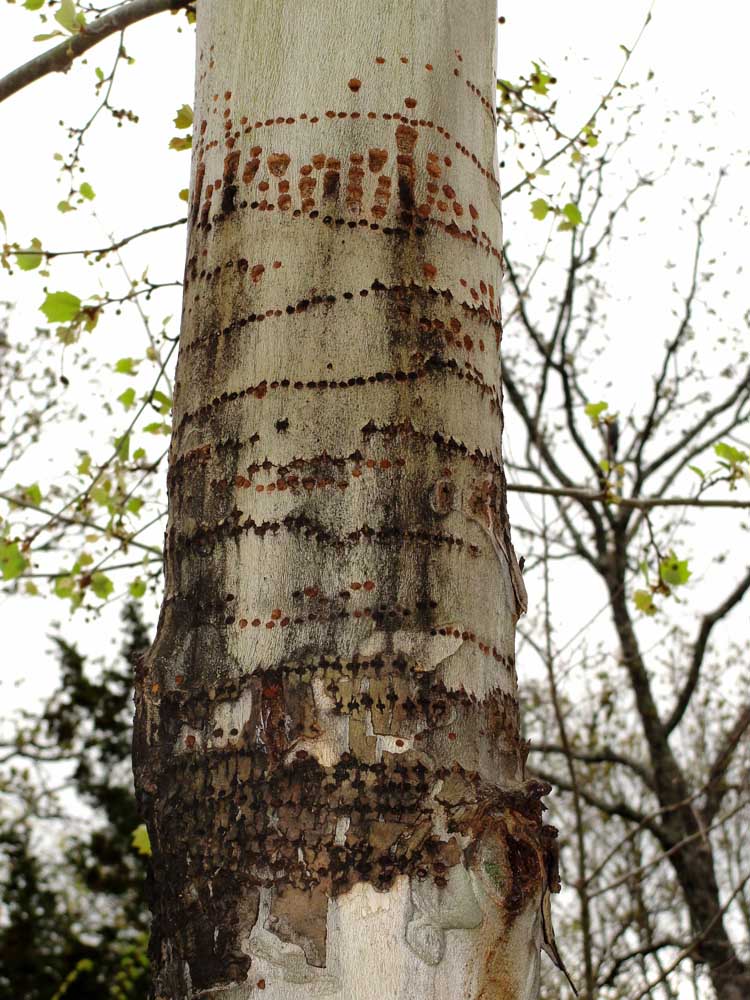Yellow-bellied sapsuckers dine on healthy, live trees
Published 7:49 pm Saturday, January 9, 2021

- Yellow-bellied sapsucker damage is characterized by holes in straight; horizontal rows.
The forested areas of East Texas are home to more species of woodpeckers than any other area of the state. With the ivory-billed woodpecker being extirpated (and most likely extinct) there are currently eight species of woodpeckers in East Texas. These include the pileated, Northern flicker, red-bellied, red-headed, downy, hairy, red-cockaded and yellow-bellied sapsucker.
Woodpeckers are an indicator of a healthy ecosystem as they consume and control the boring insects that kill trees plus spread the seed from fruit bearing trees and other plants to ensure future generations. Woodpeckers can occasionally be a nuisance however, with the most common offender being the yellow-bellied sapsucker (Sphyrapicus varius). There are four species of sapsucker in the U.S. but only one species in East Texas. Yellow-bellied sapsuckers are black and white, with hard-to-see yellow bellies, red caps and a red throat patch on males.
Trending
Yellow-bellied sapsuckers are fairly quiet, bluebird sized birds. They do have a call somewhat like a house cat though.
They are the only species of woodpecker in East Texas that is migratory, spending the winters here and the spring, summers and falls in the northern U.S. and Canada. Each October, they show up and do something no other woodpecker does. Whereas all other woodpeckers dine on insects inside of dead and dying trees using their long, barbed tongues, sapsuckers use their paint brush-like tongues to feed on the sap of healthy live trees. They make holes in the bark of sap-flowing trees (usually young trees and those with smooth bark). The sapsuckers later visit these wells to lap up the sap along with any insects caught in the sticky goo.
Tiny sap wells excavated by the yellow-bellied sapsucker usually occur in straight rows on a variety of trees in such a fashion that they look like bullet holes from a gun. The feeding rarely kills a tree. The sapsucker usually makes new holes in line with the old holes. The sapsucker makes two types of holes: deeper round holes and more shallow rectangular holes. The sapsucker licks sap from these holes and may also eat the cambium of the tree.
Trees can have holes for a number of reasons, including other woodpeckers, nuthatches and wood boring bark beetles. Sapsucker damage is notable because the holes are pecked close together, in rows, in living tissue, with the newest holes showing up during the winter. Other types of holes are not uniformly aligned. Exit holes from borers are larger and not in rows.
Sapsuckers prefer trees with thin bark, such as maples and pears but also elms, oaks, pecans, pines and around here, camellias and sasanquas. Generally, trees with thick, furrowed bark are less prone to damage than smooth-barked trees. Most trees recover from minor damage, but excessive numbers of holes can occasionally lead to girdling of the branch or tree, resulting in mortality.
Sapsuckers, like all native birds, are protected by state and federal laws, so lethal control is not an option. A more common control method is to discourage the sapsucker from returning by wrapping burlap, screen or netting around the affected area from fall until spring.
Trending
Greg Grant is the Smith County horticulturist for the Texas A&M AgriLife Extension Service. He is author of Texas Fruit and Vegetable Gardening, Heirloom Gardening in the South, and The Rose Rustlers. You can read his “Greg’s Ramblings” blog at arborgate.com, read his “In Greg’s Garden” in each issue of Texas Gardener magazine (texasgardener.com), and follow him on Facebook at “Greg Grant Gardens.” More science-based lawn and gardening information from the Texas A&M AgriLife Extension Service can be found at aggieturf.tamu.edu and aggie-horticulture.tamu.edu.



